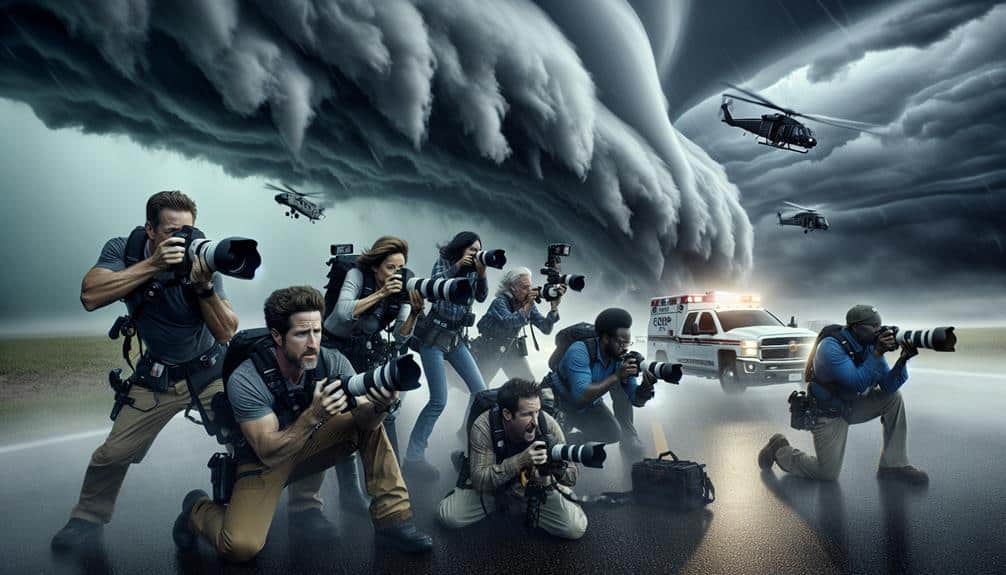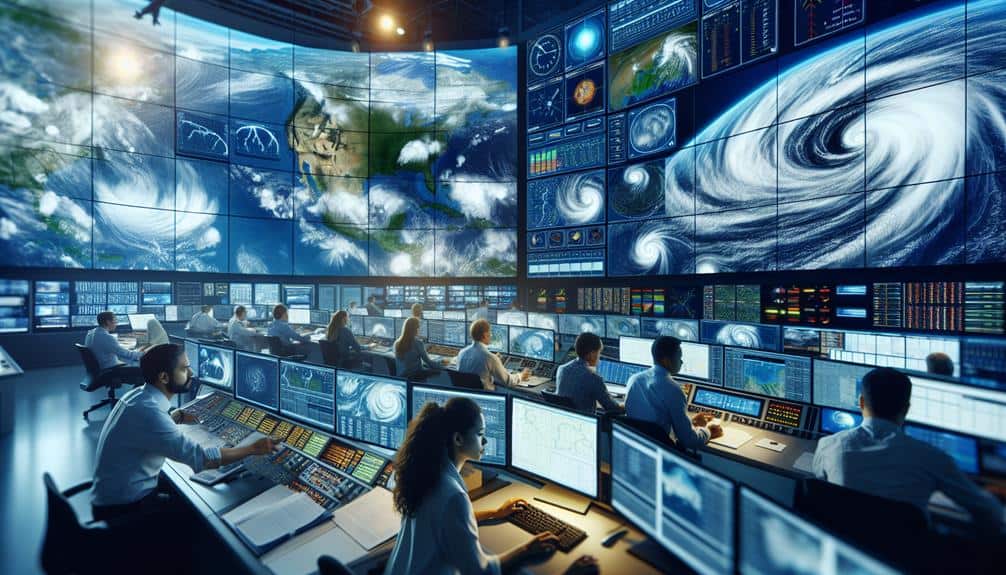Our emergency response efforts excel when we integrate storm chasers' advanced data-gathering and real-time reporting. Utilizing radar analysis and drones, we track storms with precision, collecting high-resolution data on trajectories, wind speeds, and precipitation levels. Crowdsourced data from mobile apps and live streams, paired with social media updates, enable real-time situational awareness. Collaboration with authorities ensures accurate information transfer and informed decisions, while public awareness campaigns educate communities and enhance preparedness. By leveraging these strategies, we can greatly enhance our response to severe weather events. Discover how we can make every second count in disaster management.
Key Points
- Equip storm chasers with mobile apps for real-time condition reporting, enhancing localized data accuracy.
- Use drone surveillance for flexible, high-resolution monitoring at various storm altitudes.
- Collaborate with authorities to integrate real-time data into emergency management systems.
- Engage in public awareness campaigns to educate on severe weather risks and safety measures.
Early Detection Techniques
Early detection techniques are vital for storm chasers to effectively gather data that enhances emergency response efforts. By employing radar analysis, we can track storm development with remarkable precision. Radar systems provide us with real-time information on wind velocities, precipitation intensity, and storm cell structure. This data allows us to predict storm paths and identify potential hazards before they escalate.
In addition to radar, drone surveillance has revolutionized our approach. Drones equipped with high-resolution cameras and sensors give us the flexibility to monitor storm systems from various altitudes and angles. They can safely capture data from within storm environments that are otherwise too dangerous for human presence. This technology enables us to obtain critical visual and atmospheric data, further refining our predictive models.
Combining radar analysis with drone surveillance, we achieve a thorough understanding of storm dynamics. This multi-faceted approach not only improves our forecasting accuracy but also empowers emergency responders with actionable insights.
As storm chasers, our ultimate goal is to provide the most timely and accurate information possible, ensuring communities have the freedom to prepare and respond effectively to severe weather events.
Data Collection Methods
Our data collection methods are carefully crafted to capture detailed meteorological information essential for improving emergency response strategies. We rely on a combination of remote sensing technologies and crowdsourced data to ensure extensive coverage and accuracy.
Remote sensing involves using satellite imagery, radar, and other advanced tools to monitor storm developments in real-time. These instruments provide us with high-resolution data on storm trajectories, wind speeds, and precipitation levels, which are vital for predictive modeling and risk assessment.
In addition to remote sensing, we integrate crowdsourced data from storm chasers and the public. This grassroots approach allows us to gather localized observations that might be missed by traditional methods. Storm chasers equipped with mobile apps and advanced sensors report real-time conditions such as hail size, tornado formations, and flood levels.
These data points are invaluable for cross-referencing remote sensing data, enhancing our overall situational awareness.
Real-Time Reporting
By harnessing the power of both remote sensing and crowdsourced data, we can provide real-time reporting that greatly enhances the effectiveness of emergency response efforts. Live streaming from storm chasers in the field allows us to capture immediate, high-resolution visual data on evolving weather conditions. This information is vital for meteorologists and emergency responders to make informed decisions swiftly.
We also leverage social media engagement to disseminate important updates to the public. Platforms like Twitter and Facebook enable us to share real-time information, including storm paths, evacuation routes, and safety tips. These platforms' wide reach guarantees that our data is accessible to a broad audience, empowering individuals to take timely actions to safeguard themselves and their property.
Integrating remote sensing technology, such as Doppler radar and satellite imagery, with on-the-ground reports, creates a detailed picture of the storm's impact. Real-time reporting doesn't just inform; it enables proactive measures, reducing the time between data collection and action.
Collaboration With Authorities
Partnering closely with local, state, and federal authorities allows us to synchronize our storm-chasing efforts with their emergency response protocols. By doing so, we enhance the overall effectiveness of disaster management strategies.
Our collaboration strategies involve establishing clear and reliable communication protocols that guarantee timely and accurate information sharing. This reduces response times and minimizes the risk to both responders and the public.
One crucial aspect is integrating our real-time data with emergency management systems. By providing authorities with precise meteorological data, we enable them to make informed decisions regarding evacuations, resource allocation, and public safety measures. Our coordinated efforts ensure that emergency response teams are fully aware of the evolving storm conditions, which allows for more agile and adaptive responses.
To achieve this, we employ advanced communication technologies that facilitate seamless data transfer between our teams and the authorities. Regular joint training exercises help us refine these communication protocols, guaranteeing that all parties are proficient in utilizing the tools and data available.
Public Awareness Campaigns

Educating the public about severe weather risks and safety measures through targeted awareness campaigns is essential to enhancing community resilience. By leveraging community engagement and media outreach, we can greatly improve public preparedness and response to severe weather events.
Our first step involves utilizing data-driven strategies to identify at-risk populations. We can then tailor our messaging to address specific vulnerabilities within these communities. For example, in tornado-prone areas, we should focus on communicating the significance of having a designated safe room.
Community engagement plays a vital role in these campaigns. By hosting workshops, town hall meetings, and school programs, we provide direct interaction and foster a culture of preparedness. These events allow us to disseminate accurate information and debunk common myths about severe weather.
Media outreach amplifies our message, ensuring it reaches a broader audience. Collaborating with local news stations, social media platforms, and radio stations allows us to deliver timely, precise information. Real-time updates and educational segments can keep the public informed and ready to act.
Frequently Asked Questions
How Can Storm Chasers Contribute to Post-Disaster Recovery Operations?
We can improve post-disaster recovery by leveraging community engagement and creating volunteer opportunities. Effective resource allocation and coordination efforts guarantee precise, data-driven responses, empowering communities while respecting their autonomy and boosting resilience.
What Technology Advancements Have Improved Storm Chasers' Effectiveness?
Harnessing the winds of change, we've seen drone reconnaissance and real-time data analysis revolutionize storm chasing. These advancements let us gather precise storm patterns and provide immediate insights, empowering us to safeguard lives and properties more effectively.
How Do Storm Chasers Stay Safe During Extreme Weather Events?
We stay safe during extreme weather events by following strict safety precautions and emergency protocols. We use real-time data analysis, GPS tracking, and communication networks to avoid hazardous zones and guarantee our team remains secure and operational.
What Training Is Required for Someone to Become a Storm Chaser?
To become storm chasers, we need rigorous training in safety protocols and hands-on field experience. It's a dance with nature, requiring precise knowledge of meteorology, risk assessment, and emergency response to guarantee both our safety and effectiveness.
How Do Storm Chasers Fund Their Expeditions and Equipment?
We often secure our funding sources through sponsorship opportunities and crowdfunding. Equipment costs are substantial, so we employ various fundraising strategies, including grants and donations, to guarantee we're well-equipped for our expeditions.

